Related Research Articles

Morocco, officially the Kingdom of Morocco, is a country in the Maghreb region of North Africa. It overlooks the Mediterranean Sea to the north and the Atlantic Ocean to the west, and has land borders with Algeria to the east, and the disputed territory of Western Sahara to the south. Morocco also claims the Spanish exclaves of Ceuta, Melilla and Peñón de Vélez de la Gomera, and several small Spanish-controlled islands off its coast. It spans an area of 446,300 km2 (172,300 sq mi) or 716,550 km2 (276,660 sq mi),, and with a population of roughly 37 million Citizens. Its official and predominant religion is Islam, and the official languages are Arabic and Berber (Tamazight); French and the Moroccan dialect of Arabic are also widely spoken. Moroccan identity and culture is a mix of Arab, Berber, African and European cultures. Its capital is Rabat, while its largest city is Casablanca.
The history of human habitation in Morocco spans since the Lower Paleolithic, with the earliest known being Jebel Irhoud. Much later Morocco was part of Iberomaurusian culture, including Taforalt. It dates from the establishment of Mauretania and other ancient Berber kingdoms, to the establishment of the Moroccan state by the Idrisid dynasty followed by other Islamic dynasties, through to the colonial and independence periods.

Berbers or the Berber peoples, also called by their contemporary self-name Amazigh or Imazighen, are a diverse grouping of distinct ethnic groups indigenous to North Africa who predate the arrival of Arabs in the Arab migrations to the Maghreb. Their main connections are identified by their usage of Berber languages, most of them mutually unintelligible, which are part of the Afroasiatic language family. They are indigenous to the Maghreb region of North Africa, where they live in scattered communities across parts of Morocco, Algeria, Libya, and to a lesser extent Tunisia, Mauritania, northern Mali and northern Niger. Smaller Berber communities are also found in Burkina Faso and Egypt's Siwa Oasis.

Mohammed al-Khamis bin Yusef bin Hassan al-Alawi, better known simply Mohammed V, was the last Sultan of Morocco from 1927 to 1953 and from 1955 to 1957, and first King of Morocco from 1957 to 1961. A member of the 'Alawi dynasty, he played an instrumental role in securing the independence of Morocco from France and Spain.

Agadir is a major city in Morocco, on the shore of the Atlantic Ocean near the foot of the Atlas Mountains, just north of the point where the Souss River flows into the ocean, and 509 kilometres (316 mi) south of Casablanca. Agadir is the capital of the Agadir Ida-U-Tanan Prefecture and of the Souss-Massa economic region.
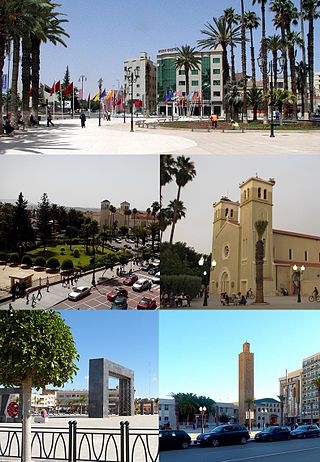
Oujda is a major Moroccan city in its northeast near the border with Algeria. Oujda is the capital city of the Oriental region of northeastern Morocco and has a population of about 558,000 people. It is located about 15 kilometres west of the Moroccan-Algerian border in the south of the Beni-Znassen Mountains and about 55 km south of the Mediterranean Sea coast.
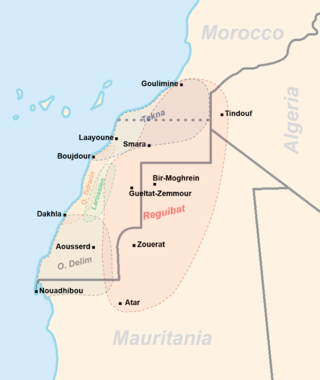
The Sahrawis, or Sahrawi people, are an ethnic group native to the western part of the Sahara desert, which includes the Western Sahara, southern Morocco, much of Mauritania, and along the southwestern border of Algeria. They are of mixed Hassani Arab and Sanhaji Berber descent, as well as West African and other indigenous populations.

The Barghawatas were a Berber tribal confederation on the Atlantic coast of Morocco, belonging to the Masmuda confederacy. After allying with the Sufri Kharijite rebellion in Morocco against the Umayyad Caliphate, they established an independent state in the area of Tamesna on the Atlantic coast between Safi and Salé under the leadership of Tarif al-Matghari.

Al Hoceima is a Riffian city in the north of Morocco, on the northern edge of the Rif Mountains and on the Mediterranean coast. It is the capital city of the Al Hoceima Province. It is situated in the territory of the Ibaqouyen and Aith Ouriaghel tribes of the Rif region, who speak a Riffian variety of the Berber language locally called Tmaziɣt or Tarifit. The city is a known tourist destination despite its small size. It has a population of about 56,716, according to the 2014 census.
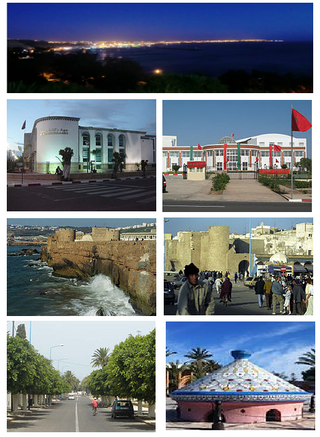
Safi or Asfi is a city in western Morocco on the Atlantic Ocean. It is the capital of Asfi Province. It recorded a population of 308,508 in the 2014 Moroccan census. The city was occupied by the Portuguese Empire from 1488 to 1541, was the center of Morocco's weaving industry, and became a fortaleza of the Portuguese Crown in 1508. Safi is the main fishing port for the country's sardine industry, and also exports phosphates, textiles and ceramics. During the Second World War, Safi was the site of Operation Blackstone, one of the landing sites for Operation Torch.

Nador is a coastal city and provincial capital in the northeastern Rif region of Morocco with a population of about 161,726.
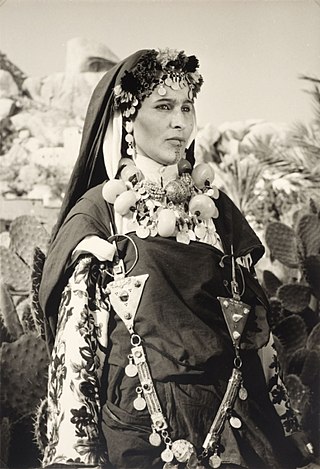
The Shilha people, or Schleuh or Ishelhien, are a Berber subgroup primarily inhabiting the Anti Atlas, High Atlas, Sous Valley, and Soussi coastal regions of Morocco.

Berkane is a city in northeastern Morocco, in the tribal area of Aït Iznasen, limited by the Mediterranean to the north, the Kis river and Oujda Province in the east, Nador Province to the west, and Taourirt Province in the south. It is the capital of Berkane Province.

Oriental région or Oujda region is one of the twelve regions of Morocco, located in the north-eastern part of the country. It covers an area of 90,127 km² and has a population of 2,314,346 and is the easternmost region of Morocco.
Berber Americans, American Berbers or Amazigh Americans, are Americans of Berber descent. Although a part of the population of the Maghreb is of Berber descent, only 1,327 people declared Berber ancestry in the 2000 US census. People of Berber origin in United States have created several associations with goal of maintaining and strengthening their language and culture, such as the Amazigh Cultural Association in America (ACAA), The United Amazigh Algerian (UAAA), The Amazigh American Association of Washington, D.C., and the Boston Amazigh Community.

The Royal Palace or Dar al-Makhzen is the primary and official residence of the king of Morocco in Rabat. It is situated in the commune of Touarga. Its official name is El Mechouar Essaid, lit. 'Venue of Happiness'.
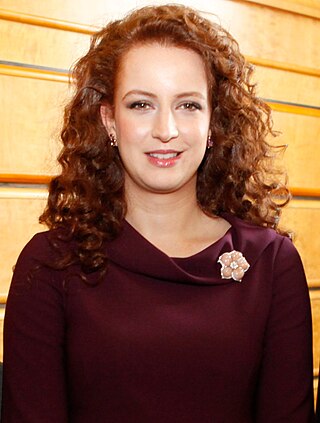
Lalla (Lella), Řalla or Řadja is an Amazigh word and title meaning "Lady", "My lady", "Miss." or "Mrs.".
Hassan Aourid is a Moroccan writer. He was born in Errachidia. He has a PhD in political science and lectures at the Mohammed V University. He has published widely in both Arabic and French. He has written half a dozen novels:
The Campaign of Tlemcen or Tlemcen campaign was a military operation led by the Saadians of Mohammed ash-Sheikh against Tlemcen in 1557, then under the domination of the Regency of Algiers, a vassal state of the Ottoman Empire. Mohammed ash-Sheikh, who wanted to conquer Algeria, occupied the city but failed to seize the Mechouar Palace which was defended by a garrison of 500 men under the command of Caid Saffa.
References
- ↑ Johnstone, Patrick; Miller, Duane (2015). "Believers in Christ from a Muslim Background: A Global Census". IJRR. 11: 14. Retrieved 20 November 2015.
- ↑ Fontaine, Darcie (2016). Decolonizing Christianity: Religion and the End of Empire in France and Algeria. Cambridge University Press. p. 173-175. ISBN 9781107118171.
- ↑ Ethnicity in health (care) - Mikado, By K Stronks [ permanent dead link ]